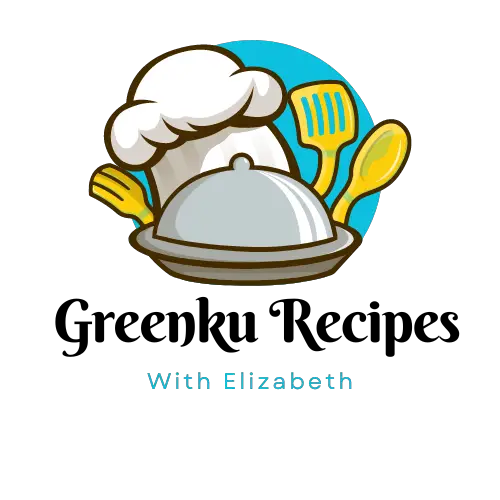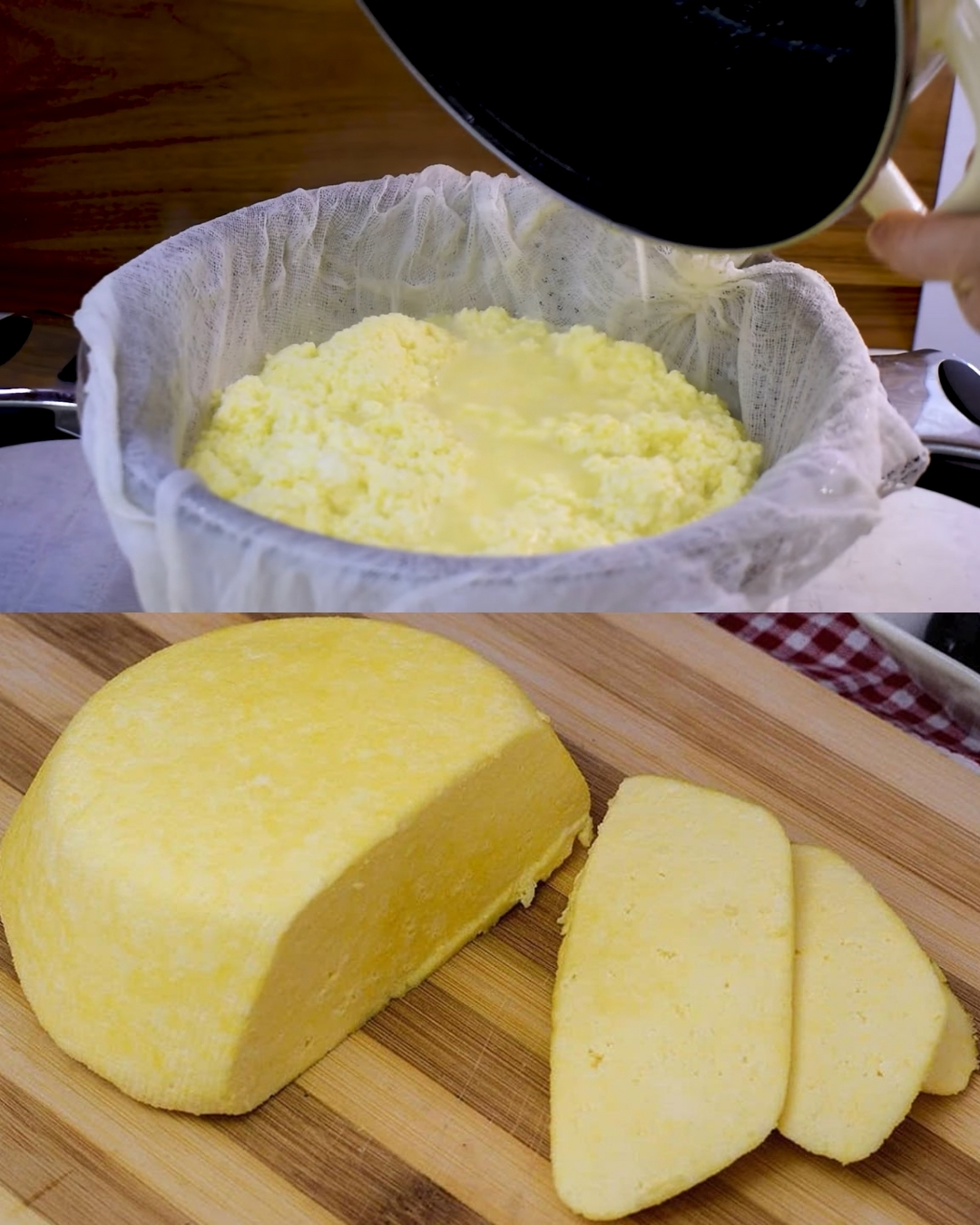Discover how to make a simple, young cheese at home using just milk, eggs, and a few pantry staples. This method yields a creamy, slightly tangy cheese with a lovely yellow hue—perfect for grating over salads, stirring into pasta, or snacking on its own. In under two hours, you’ll transform fresh milk into nearly half a kilogram of fresh cheese, with minimal equipment and no special ingredients.
Cooking Time
Preparation: 5 minutes
Cooking & curd formation: 8–15 minutes
Draining & pressing: 60–90 minutes
Total: 1 ½ – 2 hours
Ingredients
• 1.5 L fresh whole milk
• 3 large eggs
• 1 tsp salt (plus more to taste)
• Optional seasonings: black pepper, herbs
Step-by-Step Cooking Directions
-
In a medium bowl, crack three eggs and whisk briefly. Add 1 tsp salt (adjust to preference) and whisk again until uniform. Set aside.
-
Pour 1.5 L milk into a heavy-bottom saucepan and bring to a gentle boil over medium heat, stirring occasionally to prevent scorching.
-
Once the milk reaches a rolling boil, reduce heat to low. Gradually drizzle in the egg-salt mixture in a thin stream, stirring constantly.
-
Continue to cook over low heat, stirring gently, until curds form and separate from the whey—about 8 minutes with fresh homemade milk, up to 15 minutes with store-bought milk. You’ll see distinct white curd lumps floating in golden whey.
-
Remove from heat and let sit 2 minutes. Using a slotted spoon or spatula, transfer the curds into a fine-mesh strainer lined with cheesecloth or a thin towel. Let drain for a minute.
-
Gather the cheesecloth edges and gently squeeze to remove excess whey—be careful of heat. To form a neat shape and expel moisture, press the wrapped curds on a plate, place a small weight (a water bottle or can) atop, and let sit 1–1 ½ hours at room temperature.
-
Unwrap and transfer the cheese to a cutting board. Grate or slice as desired. You should yield approximately 446 g of cheese from 1.5 L milk.
Nutritional Information (per 100 g approximate)
Calories 260 kcal • Protein 18 g • Fat 20 g • Carbs 2 g • Calcium 600 mg • Sodium varies
Origins and Popularity of the Method
Egg-coagulated cheeses trace back to home-cheesemaking traditions where cooks used kitchen staples—eggs, acid, or heat—to curdle milk when rennet or cultures were unavailable. This quick curdling produces “tsura” in parts of Eastern Europe and “mazzamorra” in Latin American home recipes. Its ease and speed make it popular among DIY cheese enthusiasts and families seeking preservative-free, fresh cheese.
Reasons Why You’ll Love the Recipe
-
Ultra-simple: No special equipment—just a pan and strainer.
-
Quick turnaround: Cheese ready to eat in under two hours.
-
Minimal ingredients: Milk, eggs, and salt.
-
Budget-friendly: Uses basic pantry staples.
-
Customizable: Add herbs, spices, or garlic for flavor.
-
Versatile: Grate, slice, melt, or crumble.
-
Preservative-free: Enjoy pure, fresh cheese.
-
Kid-friendly: Fun, hands-on kitchen project.
-
Impressively yielding: Nearly 450 g from 1.5 L milk.
-
Healthy: High in protein and calcium.
Health Benefits
• Provides complete protein from milk and eggs.
• Rich in calcium and phosphorus for bone health.
• Contains vitamin A from egg yolks.
• Free of artificial preservatives and additives.
Serving Suggestions
• Grate over pasta, risotto, or salads.
• Stir into scrambled eggs or omelets.
• Layer in sandwiches or quesadillas.
• Serve cubed with fresh fruit and crackers.
Common Mistakes to Avoid
• High heat: Boiling too vigorously can scorch milk—maintain low simmer.
• Adding eggs too fast: Causes lumps—drizzle slowly with stirring.
• Insufficient draining: Cheese will be soggy—press adequately.
• Skipping salt: Results in bland curds—season while whipping eggs.
Cooking Tips
• Use full-fat milk for richer cheese and higher yield.
• Warm milk gradually to prevent sudden temperature shock.
• Line strainer with two layers of cheesecloth for finer curds.
• Weigh cover to achieve a firmer texture—adjust pressing time for softer or drier cheese.
Similar Recipes to Try
• Ricotta from lemon-acid curdling
• Paneer (Indian fresh cheese)
• Queso fresco with vinegar curdling
• Yogurt cheese (labneh)
Variations to Try
• Herbed cheese: Stir in chopped chives, dill, or parsley before pressing.
• Garlic & chili: Mix minced garlic and red pepper flakes into curds.
• Spiced: Add za’atar or smoked paprika to egg mixture.
• Sweet cheese: Skip salt, add a touch of honey and vanilla for dessert cheese.
Advertisement
Ingredient Spotlight
Eggs: Act as both coagulant and flavor booster. Their proteins denature in hot milk, helping curds form and adding richness.
Conclusion
Homemade Egg-Coagulated Cheese offers a fast, foolproof way to enjoy fresh cheese anytime. With just milk, eggs, and salt, you’ll produce a delightfully creamy, versatile cheese that brightens dishes and satisfies homemade cravings—no waiting or special tools required.
Frequently Asked Questions
-
Can I use low-fat milk?
Yes, but yield and creaminess will be lower. -
Why didn’t curds form?
Milk not hot enough or egg mixture added too quickly—ensure gentle boil and slow drizzle. -
Can I add vinegar instead of eggs?
Yes, 2 Tbsp vinegar or lemon juice can curdle milk for ricotta-style cheese. -
How long does the cheese keep?
Refrigerate in sealed container up to 5 days. -
Can I eat the whey?
Yes, use it for soups, smoothies, or baking as a protein-rich liquid. -
Can I heat the cheese further?
Melt it gently over low heat; beware of separation. -
Why is my cheese grainy?
Overcooking curds or too much heat—cook gently until just formed. -
Can I make vegan version?
Use silken tofu blended with aquafaba and nutritional yeast. -
How firm will it be?
Press time determines firmness—longer pressing yields dryer, sliceable cheese. -
What equipment do I need?
A saucepan, whisk, strainer, cheesecloth (or clean towel), and a weight for pressing.

